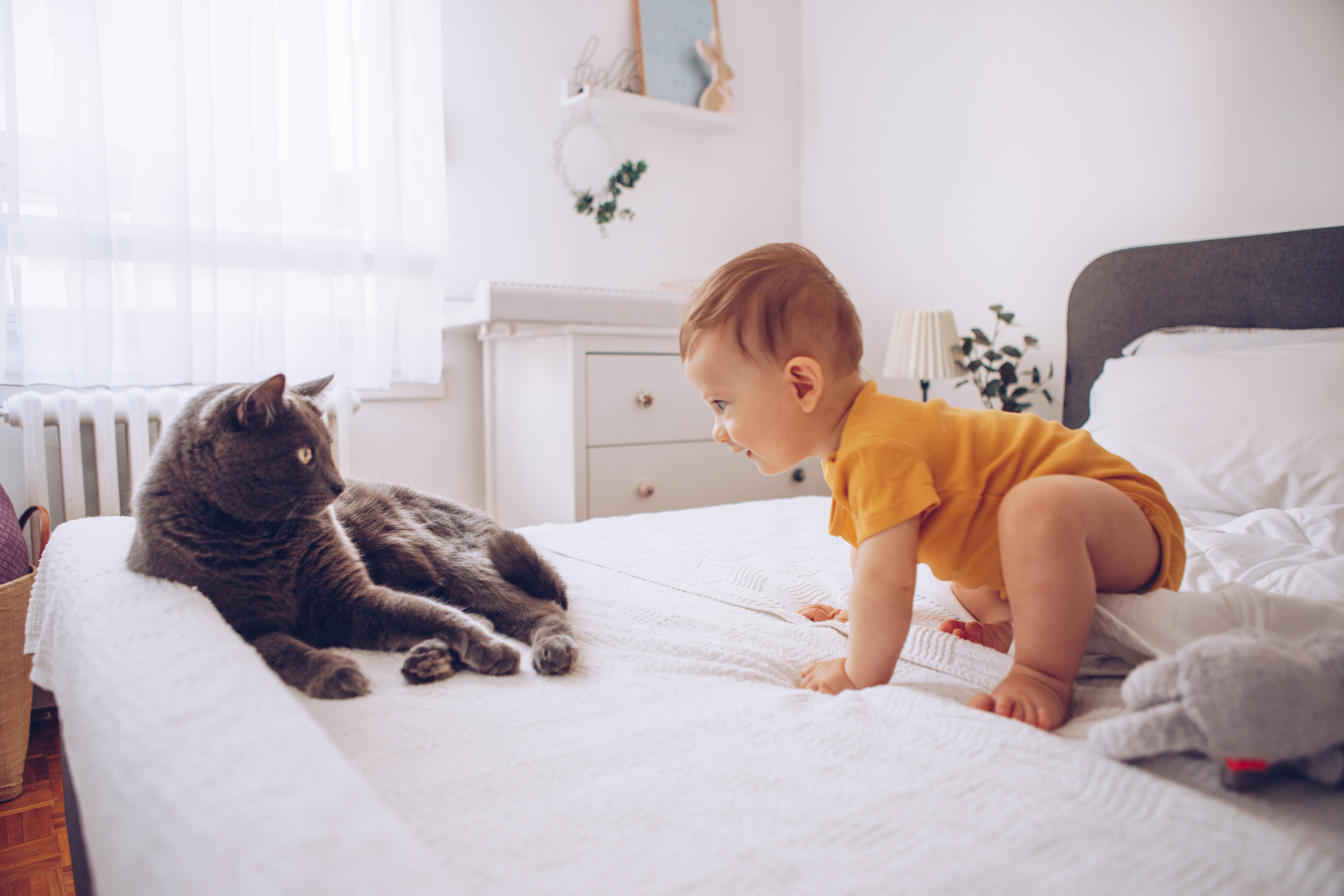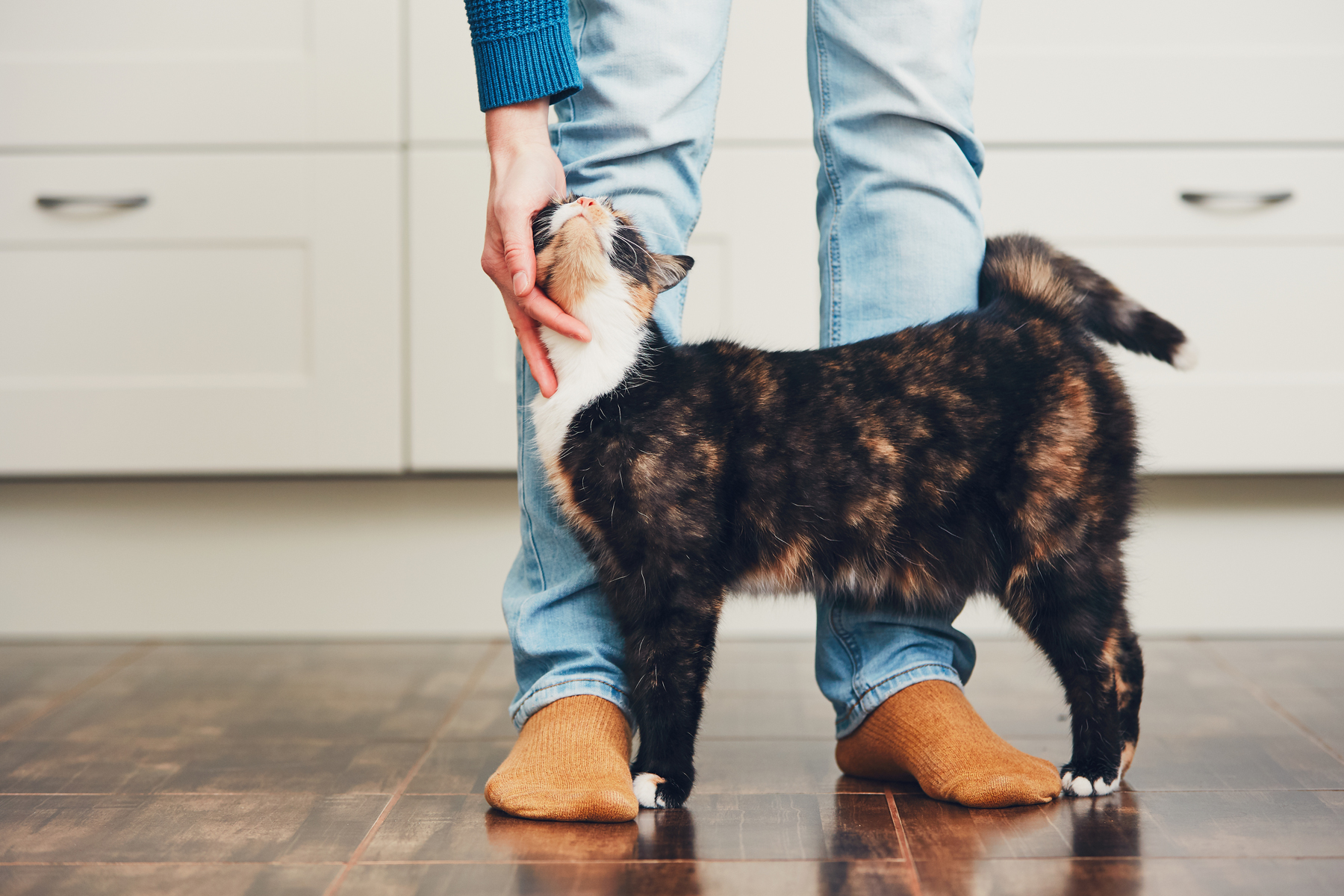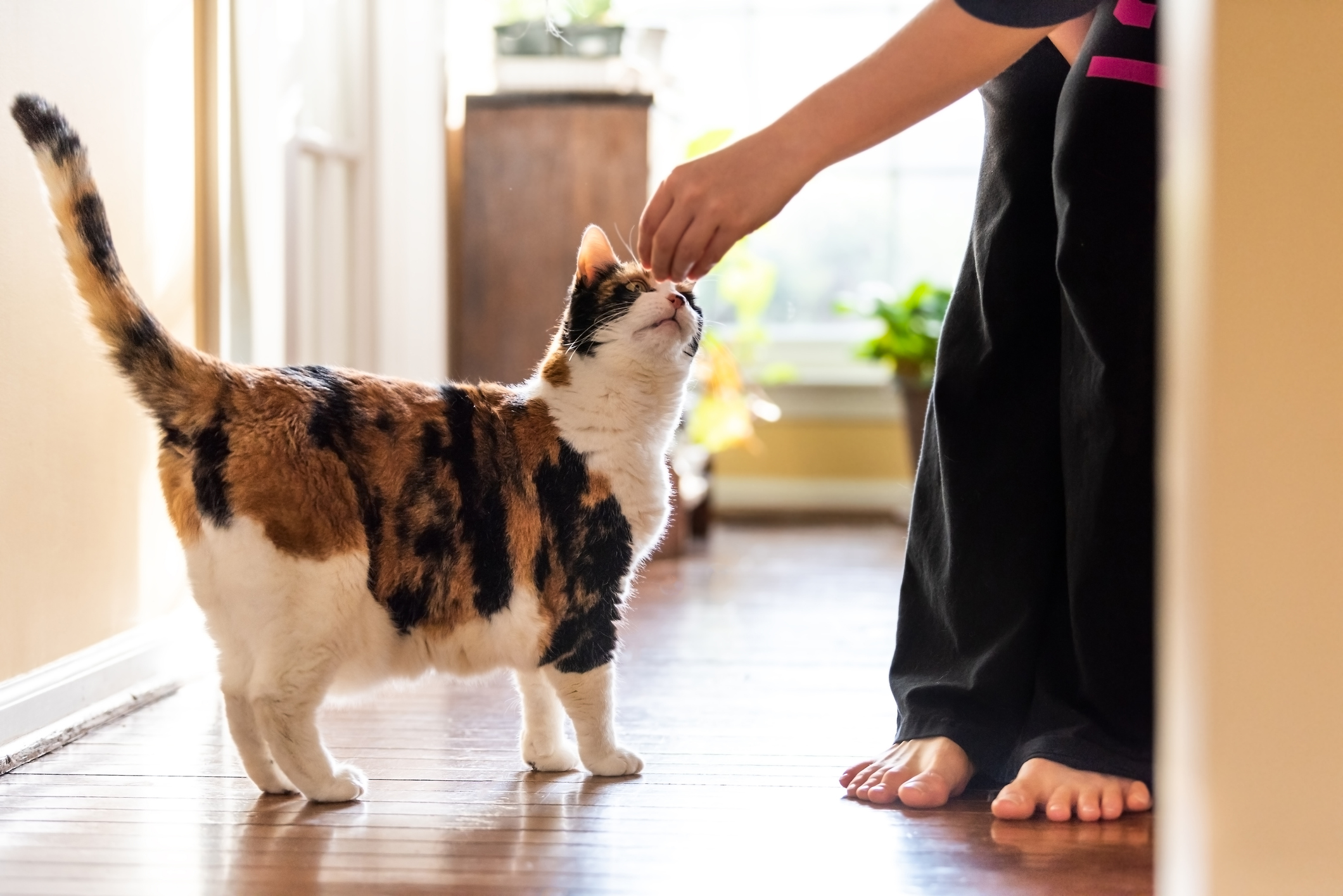How to keep children safe around cats
15th April, 2020

Children and cats can be wonderful companions, but they can also come into conflict. Even the sweetest cat may bite or scratch if it feels threatened. The good news is that this risk can be greatly reduced by taking a few simple steps.
In this article, we’ll give you some top tips on introducing children to felines and underline the importance of protecting your cats with multi pet insurance.
See children through your cat’s eyes
From a cat’s perspective, a child is a noisy, smelly, wriggly creature who has been brought into their territory. To make matters worse, this little newcomer seems to have a monopoly on your love and cuddles.
For many cats, the arrival of a child is no big deal and they even seem attached and protective of the new family member from day one. For others a baby causes an epic sulk, with the puss sneaking off into a quiet corner, going outside more often or even disappearing for long periods.
A small minority of cats will show hostile behaviour or mark their territory with urine in response to a child.
Bringing home a baby
A new baby brings lots of change – and cats generally do not like change. The rooms are suddenly full of new noises and smells – all that gurgling, crying, milk and poopy nappies.
There will be a pram and cot and lots of new toys, all with their own smells and bright colours. Some areas are also suddenly out of bounds, so the cat can’t curl up in its favourite sunny spots any more.
Not to mention, a cat may be upset by the changes in its owner when a baby comes. The adult suddenly starts to keep different hours, singing at odd times and keeping very quiet at others, walking up and down with the baby and generally having less time to snuggle and play with the cat.
To ease this transition, do what you can to make the baby’s arrival less of a shock. You can introduce baby equipment slowly before the big arrival, wear small amounts of baby product yourself for a while and gradually introduce changes like keeping the cat out of the room where the baby will sleep.
Some owners also say that playing clips of baby crying can be helpful.
It is also advisable to ensure the cat has somewhere quiet and peaceful to go if he or she wants to get away from the baby. A box in a quiet corner or a high shelf will give the cat a safe place to retreat if they start to feel stressed.
With all the excitement around a baby arriving, it’s easy to lose track of your insurance renewals. Why not make life easier with multi pet insurance, so you have a single renewal date for all your pets?

Teaching children about cat behaviour
Even very young children can learn about the right way to behave around a cat, and what the warning signs are that a cat is becoming stressed. Children should never be left unsupervised with a cat, especially in the early days.
A child can easily make a wrong move such as pulling the cat’s tail or trying to pick it up, which can frighten a cat and cause them to lash out.
The first thing for kids to learn is to understand what a cat looks like in a relaxed, comfortable state. Rubbing against your hands or clothing, purring and holding its tail high and twitching the end all signal pleasure.
If the cat growls, puts its ears back or starts swishing, fluffing or lowering its tail to the ground, it’s a sign it feels anxious or threatened. Children should know to back off if these behaviours are shown.
Kids, especially babies and toddlers, can be heavy-handed in petting a cat. They should be shown how to stroke gently, without grabbing fur, poking or reaching for sensitive areas such as the eyes and ears. Stroking the back, shoulder, neck and top of the head with an open palm is good, but most cats dislike being touched on the face, paws, tail or tummy.
Being around a cat gives children a valuable lesson in respecting others. A cat is a separate being, not a toy, and the child should be encouraged to think about what the cat likes or does not like. For example, kids often want to pick up cats but this can stress our feline friends, particularly if the child is small and clumsy.
Children should be encouraged to sit and attract the cat to their lap with a treat or a toy, but to let it come and go as it likes.
When children are older, they can be shown how to hold the cat securely, always watching for signs such as ears going back or tail twitching, which indicate the cat wants to get down. Then the cat should be gently lowered to a suitable surface.
It is useful to teach children about cat behaviour even if you do not have a pet cat in your own home. It is likely that your offspring will visit other homes with cats or encounter them in the street, so knowing how to read their body language is a valuable skill.
It may be useful to teach them about what to do if they find a dead cat, in case they come across one when outside.
Choosing a cat for your home
Not all cats suit homes with children, so care should be taken when selecting a pet for your family. The first question is whether it is the right time to take on a new pet.
Cats and kittens need lots of care and attention, especially in the initial settling in period. It’s heartbreaking to give up a pet because you can’t cope with the demands on your time, so think carefully before adding to your family.
Cats can also be expensive – with food, cattery costs, and vet bills all adding up. Thankfully, insurance can help with vet bills if your cat becomes sick. Using quality pet insurance, which covers more than one pet, could help you save even more.
Choosing a cat should be about much more than their looks. Any decent breeder or rehoming centre will help you work out whether the cat you plan to take home is suited to living with children. Certain pedigree breeds also tolerate children better than others.
Some rescue centres are risk-averse, preferring only to place cats with homes with older children. If your children are particularly chaotic, you might wish to put off getting a cat for a few years.
It is always advisable to take out pet insurance, or add a new cat to your multi pet insurance, as soon as possible. 
Introducing a cat into your home
In addition to teaching your children how to read a cat’s behavioural signals, you can help to avoid conflict by preparing your home in advance of the cat’s arrival.
The cat will need a quiet, peaceful place to settle in when it first arrives, without your children. This room should have food, water, somewhere to rest and somewhere to hide.
After a few days, the cat should be comfortable enough to explore the house without your children present. When this has been done a few times, puss should be ready to meet its new playmates.
For the first meeting, ask your children to sit in a room the cat has already explored. Let the cat into the room, ensuring it can go back out easily if it wishes.
Ask the children to ignore the cat, so it can approach and smell them without feeling threatened. If your children can’t contain their excitement and try to pet or grab the cat, move the child away.
From this beginning, you can gradually increase the time the cat spends with the children. Introduce toys or treats but ensure the children know the cat should always instigate playing and that sometimes cats need their own space.
The children should learn to play in a way that keeps their hands out of harm’s reach, for example by using toys with lasers, strings or wands.
Giving the cat a treat as a reward for playing with the children will help it to form positive associations with them.
Older children can give the cat treats themselves. Even with treats involved, some cats do not like to be handled by children. Children must be taught to respect this – they can still have fun together with hands-free toys.
If you have younger children, using baby gates can be really useful to make the upstairs a cat refuge during daytime play. The cat’s food, water and litter tray should also be kept away from little ones.
If your cat is going to be allowed outdoors, this also needs to be handled carefully and built up slowly. If the worst happens and the cat is knocked down by a car, goes missing or is stolen, multi pet insurance helps with the cost of vet care, advertising and reward, or compensation if the cat dies.
Health problems related to cats
Cat ownership is said to bring lots of health benefits, from supporting your mental health to helping to reduce stress and lower your heart rate.
One study found that cat owners were 30% less likely to die of a heart attack or stroke than non-cat owners, and children’s immune systems are boosted by having a furry friend around.
That said, there are a few risks posed by having a cat. It’s worth being well-informed so that you can minimise the risk to you and your children, as well as taking rapid action if needs be.

Toxoplasmosis
Cats are the primary host carriers for a common parasite, toxoplasma gondii. If pregnant women come into contact with the parasite, an infection can develop which may harm the developing fetus.
Risk can be considerably reduced by emptying the litter tray twice daily, pregnant women avoiding the litter tray or using disposable gloves and face mask, plus food safety precautions such as hand washing and scrubbing fruit and vegetables.
The risk is higher if cats can go outside and dig in infected soil or come into contact with the faeces of other cats.
Your vet will be able to advise you about parasites and the risk they pose to your children. Make sure your vet costs are covered by purchasing specialist pet insurance.
Puncture wounds
Bites and scratches from cats are unlikely to cause major injury, for example compared to a bite from a dog. However, minor scratches from cats are relatively common, as they can accidentally scratch during play or grooming.
Injuries caused by cats can lead to infection which can spread to blood or other parts of the body. In the most dire cases, tetanus or rabies can be contracted through a bite - but these are very unlikely to be caught from your household pet!
If your child’s skin is broken by a cat bite or scratch, clean the wound under running tap water for a few minutes to clean the wound and remove any dirt. Unless the wound is bleeding freely, squeeze it slightly so the blood will help wash out any bacteria.
Dry the wound and cover it with clean dressing or plaster and seek medical advice unless the wound is very minor. Seek medical advice as soon as possible and give age-appropriate pain relief if needed.
You should get immediate medical help if a wound seems to be infected. Signs to watch out for include redness and swelling around the wound, pus and liquid leaking from the site, increasing pain and warmth, fever and chills, swollen glands or red streaks around the wound.
Allergies
A cat allergy is the result of being hypersensitive to a substance called Fel d 1, which is a protein that coats the cat’s hair. It is produced by the cat’s sweat, salivary and anal glands.
Allergy sufferers experience symptoms such as sneezing, itchy, runny nose and eyes, itchy rashes, wheezing and, in the most severe cases, trouble breathing or anaphylaxis. Cat allergy can also worsen asthma.
It is a good idea to have your children spend time with cats before taking one home, which should help to show if they will have allergic symptoms.
Not all cats produce the allergen at the same rate: some breeds produce less. Female cats produce less Fel d 1 than male cats, and neutered males produce less than intact toms. Trying to choose between a male and female cat may be difficult but by reading our blog it may help in giving you some clarity.
If your child shows signs of an allergy to a cat who is already living in the family, you may face a dilemma. Re-homing the cat is an option, but you may wish to see if the child builds up resistance over time, depending on the severity of the allergy.
Measures such as vacuuming regularly, washing bedding and keeping the cat out of bedrooms can also help.
Are you spending too much on pet insurance?
Pet insurance is essential if you have a cat. If you have more than one pet, multi pet insurance is a good way to make sure they are all covered without purchasing multiple polices.

Helpful Pages
Recent Posts
Pet Insurance Quote
- 98% claims paid *
- Claims paid directly to vets
- 24/7 vet video consultations
- Interest free monthly payments




